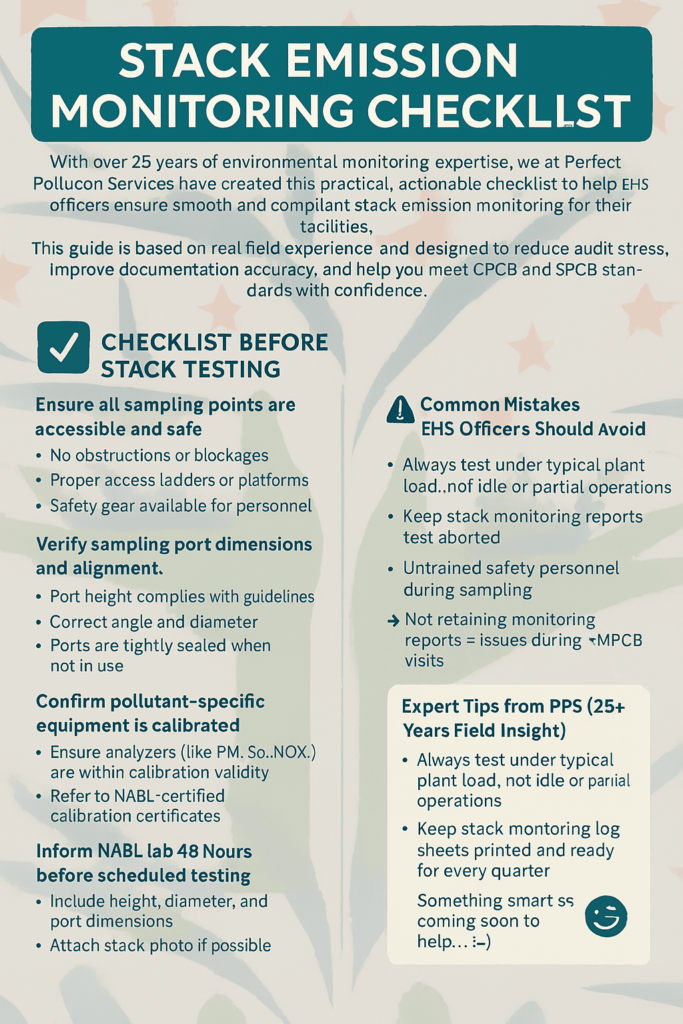Stack Emission Monitoring Checklist
With over 25 years of environmental monitoring expertise, Perfect Pollucon Services has helped more than 1,000 Indian industries streamline their environmental compliance processes. One of the most critical areas of focus is stack emission monitoring — an essential regulatory requirement for all industries operating combustion units, boilers, DG sets, or other pollution-emitting equipment.
This expanded guide is crafted for EHS officers, plant managers, and compliance teams. It provides a thorough, step-by-step checklist to help you prepare for stack monitoring, understand the documentation requirements, avoid common mistakes, and build internal systems that ensure 100% readiness for pollution control board audits.
Our Case Study on How we reduce Emissons by 30% and Ensured 100% compliance to reduce penalties
✅ Checklist Before Stack Emission Testing
Stack testing requires a blend of technical readiness and operational coordination. Missing even a single step can lead to failed tests, rescheduling, or worse, a non-compliance notice. Here are the key preparation tasks:
1. Sampling Point Accessibility
- Ensure all sampling points are safe and physically accessible.
- Check for no obstructions — stacks often get surrounded by piping or new structures over time.
- Provide permanent platforms or temporary scaffolding.
- PPE for personnel should be ready: harnesses, helmets, gloves, safety shoes.
2. Stack Port Verification
- Confirm that stack ports are placed at the correct height as per CPCB/SPCB norms.
- Ensure diameter and angle comply with isokinetic sampling requirements.
- Ports must be airtight when not in use to avoid gas leaks.
3. Equipment Calibration
- Use NABL-certified instruments like Envirotech APM 430 for PM or flue gas analyzers for SO2, NOx.
- All devices must be calibrated within the past 12 months.
- Keep calibration certificates printed and ready.
4. Advance Intimation to NABL Lab
- Inform your third-party lab partner at least 48 hours in advance (psst… it’s probably us at Perfect Pollucon Services, so we already know 😉).
- Include preferred testing date, expected load condition, safety access confirmation.
- Coordinate internally to ensure the plant is running at standard production levels during the test.
5. No Maintenance Window During Testing
- Schedule testing on a regular production day.
- Inform maintenance teams not to conduct shutdowns or partial operations during sampling.
If you need any help in Stack Emission Monitoring We are here to help!
📄 Essential Documentation Stack Emission Monitoring Checklist
Monitoring is only part of compliance. Documentation ensures you’re audit-ready at any time.
1. Stack Drawing with Sampling Port Marked
- A technical drawing showing stack height, internal diameter, and port location.
- Attach an actual site photo of the stack for clarity.
2. Historical Monitoring Reports
- Maintain at least 1 year’s worth of reports.
- Highlight any exceedances and the corrective actions taken.
3. Equipment Calibration Certificates
- Both primary and backup instruments must have valid calibration.
- Keep both soft and hard copies.
4. Production Log for Testing Date
- Include hourly production data.
- Helps prove that the emission results are reflective of standard load.
5. DG Set Stack Data (if applicable)
- DG sets must be tested separately.
- Log generator hours and fuel consumption.

⚠️ Common Mistakes That Can Trigger Show Cause Notices
Many industries make avoidable errors that can escalate into serious compliance issues:
- Not informing the lab in advance, leading to misalignment in schedules.
- Sampling port not conforming to required standards.
- No documentation of past tests during MPCB visits.
- Untrained personnel supervising the test.
- No SOPs for stack emission events or corrective actions.
PPS recommends creating a stack monitoring SOP binder with all documents arranged month-wise, so even if EHS staff changes, compliance stays intact.
🧠 PPS Expert Tips (from 25+ Years of Field Experience)
- Never schedule testing on low-production days. Your data should reflect real-world conditions.
- Use automated reminders or a compliance calendar. Set alerts 30 days before testing deadlines. (Something smart is coming soon to help…) 😉
- Train your shift supervisors to understand what happens during stack testing. They often manage the coordination.
- Use the same lab regularly for consistency in data formats and comparison.
- Document everything. Even if you stay compliant, lack of evidence can be flagged.
Read CPCB Guidelines For Stack Emission Monitoring
📉 Real-Life Scenario
One of our clients, a mid-sized food processing unit in Taloja, received a non-compliance notice due to elevated NOx readings. Upon root cause analysis by Perfect Pollucon Services, it turned out their boiler was running on high sulfur-content fuel that week. The plant shifted to a cleaner fuel, retested, and re-submitted the report within 7 days — avoiding penalties.
Lesson? Monitoring is not just a report; it’s an early warning system for operational inefficiencies.
Read more about Stack Emission Monitoring Methods
📌 Did You Know?
“Stack emissions are among the top 3 reasons why industries receive Show Cause Notices from MPCB in Maharashtra.”
Being proactive can save lakhs in fines and avoid factory closures.
📢 About Perfect Pollucon Services
PPS is an environmental monitoring and compliance expert serving Indian industries since 2000. Our services include:
- Certified Stack Emission Testing
- Ambient & Indoor Air Monitoring
- Effluent & Water Testing
- Form V & Environmental Statement Preparation
- Training and Documentation Assistance
Trusted by 20+ Fortune 500 companies and 1,000+ industrial clients.
Because Behind Every Report, There’s a Human Who Cares
At Perfect Pollucon Services, we’ve seen firsthand the pressure EHS professionals carry — juggling compliance, safety, audits, and deadlines, often with limited resources and zero room for error. One missed checklist, one overlooked document, and the consequences can be overwhelming — not just for the company, but for the individual responsible.
We created this stack emission monitoring checklist not just as a tool, but as a gesture of support. It’s our way of standing beside the EHS warriors who quietly protect our environment every single day. You deserve systems that reduce your burden, not add to it. This checklist is built from 25+ years of field experience — so that you never feel alone when compliance knocks at your door.
📧 Want to Stay Compliant Without the Stress?
You can download free Editable Stack Monitoring Log Sheet or Template (Excel format) below:
Let compliance be your strength, not your stress. Perfect Pollucon Services is here to support every step of the way.
📚 Useful Resources
“This checklist felt like a lifeline. For once, I wasn’t scrambling last-minute or second-guessing what the auditor might ask. Perfect Pollucon Services didn’t just give us a tool — they gave us peace of mind. I genuinely felt like someone out there understands what it’s like to walk in our shoes.”
— Rahul M., EHS Manager, MIDC Unit
✅ Reviewed by Our Expert Leadership Team
This service offering is created and reviewed by our senior team of environmental professionals with 10–40 years of experience in pollution control, regulatory compliance, and monitoring services.

Tanaji S. Gajare
Founder & Chairman
40+ years in air & water monitoring, sustainability leadership

Anil Shelke
Executive Director
30+ years in compliance, audits, and ETP/STP operations

Kunal Gajare
Chief Sustainability Officer
10+ years in stack monitoring, MPCB/MoEF clearances, EIA

